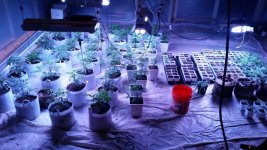G
Gr33nSanta
what do you think of using carbon pellets from old carbon filters for biochar as soil amendments?I do get your point with this. I use less drainage material than others but I do use materials like pea gravel and composted woody debris (& biochar) which do provide nutrients over time in a no till soil.
I don't quite follow what you mean here but compacted castings would contribute more to anaerobic, rather than aerobic conditions. Of course there are more than just bacteria at work in a living soil.
I'm not knocking how you do things. It sounds better than most and you have satisfaction with your routine. I don't think you mentioned whether you remix your soil between harvests or whether you are growing no till in true living soil fashion.
I have come across local peat moss previously, although not bailed. So it is not Canadian Sphagnum peat moss?
What do you mean by 'thickest hyphae mycorrhizae'? If anything there may be some endomycorrhizal fungi spores in it, just as there could be in peat moss, which could infect your roots. To my knowledge it has nothing to do with thickness of hyphae.
Unless you are getting an Alaska humus product which is not on the market, then there is a 95% chance (I'm being moderate) it contains Sphagnum peat. The only way you could tell this is by looking at it under magnification to see the Sphagnum leaves.
For general appearance, mined Sphagnum peat moss varies according to the depth mined from and drying process applied.
Here you may see some research done illustrating that Alaska 'humus' products are essentially the same as Sphagnum peat moss products.
http://www.microbeorganics.com/#Canadian_Sphagnum_Peat
Here is a photo of a Sphagnum leaf magnified 100 times and zoomed in on at unknown magnification;
View Image
You don't need to know all this to continue happily growing the way you do
I had one more question. Do you harvest your clay soil outdoors? If you've already answered, apologies.





